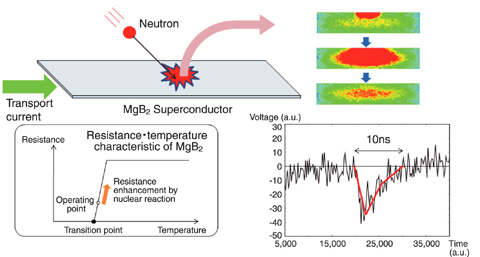
Fig.10-8
One can make a highly accurate irradiation detector by taking advantage of the properties of a superconductor, whose electrical resistance abruptly goes to zero at the superconducting transition temperature. Thus, even the tiny heat created by one radiation particle brings about a large electrical signal in superconductors (Fig.10-8). It is expected that superconducting radiation detector will develop high accuracy and be utilized as an essential detector for X- and γ-rays in astrophysics to study the origin and the development of the universe. Moreover, its ability to count only a single photon and identify a very small amount of actinide compound is considered to be quite useful in future quantum communication and the microanalysis of nuclear materials, respectively. However, very little is known on the mechanism of the radiation detection except for simple principle as described above. That is why studies for making ultra high accuracy detectors mainly follow empirically observed rules.
In order to aid the researchers engaging in measurement and experiment and contribute to its detector development in general, the research group in CCSE has tried to develop a method of predicting the detection processes by simulation.
In the developed simulation, an equation expressing the superconducting transition dynamics close to the transition point, the heat diffusion, and the Maxwell equations describing the heat transfer and the subsequent creation of the electrical signal are solved together. Thus, this code can reproduce the detection process via the superconductivity depression by the heat diffusion (Fig.10-8).
By utilizing this simulation code, we performed a simulation for the neutron detection of superconductor MgB2 and predicted the detector performance prior to experiments. Researchers have desired greatly information about the response speed of the electrical signal The reason for this is that they have to change their measurement setups according to the speed of response. The simulation revealed that the response time is on the order of a nanosecond, and the experiments in JRR-3 really confirmed that the prediction is valid. Thus, it is found that the simulation code works well and the response speed is much faster than the previous d etectors. This indicates that MgB2 has good potential as an ultra-high-speed neutron detector. Presently, further experiments and simulations are underway.
<Previous: 10-3 | Next: 11 Scientific & Technical Development for Nuclear Nonproliferation >